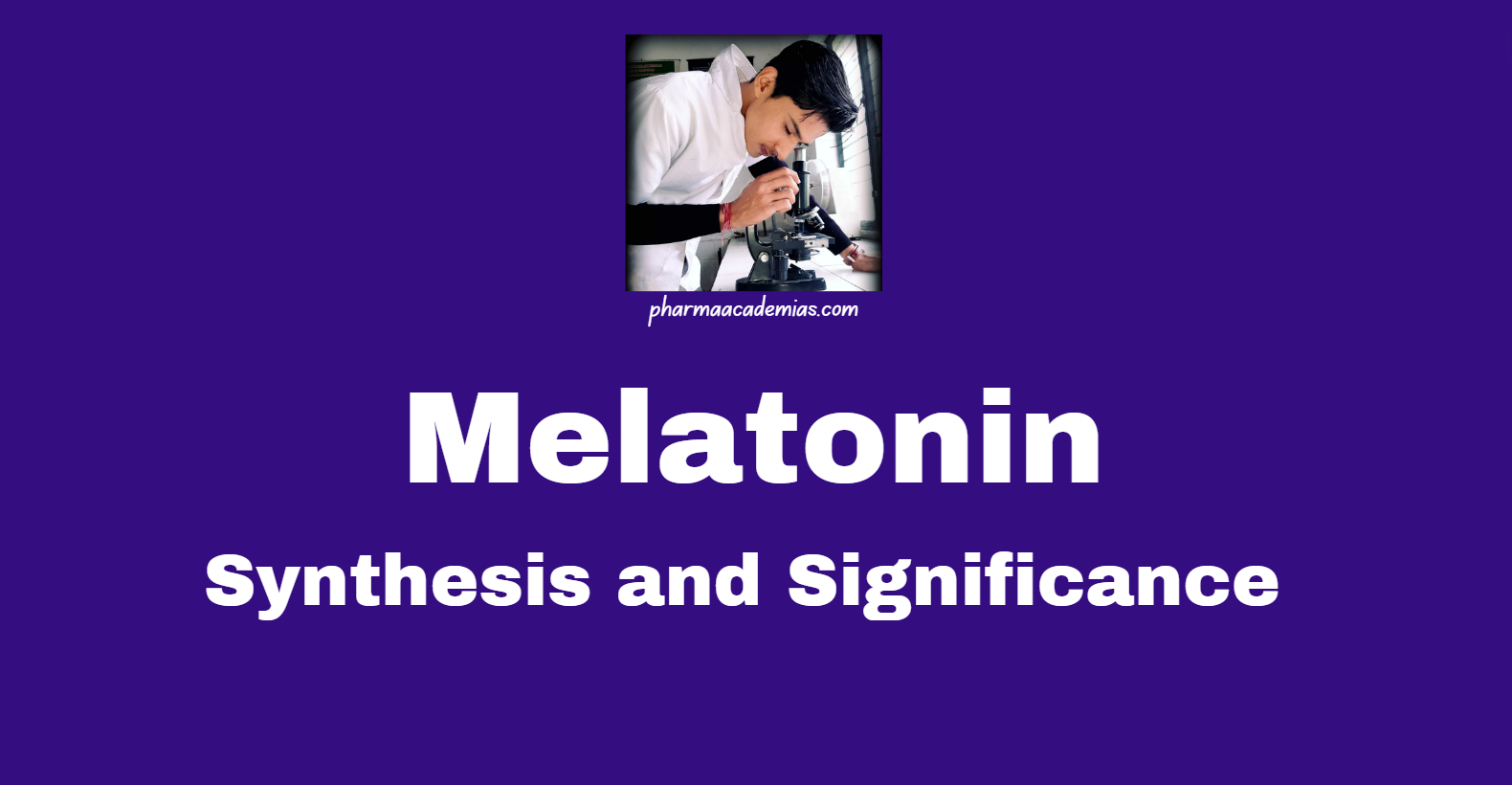Melatonin is a hormone primarily produced by the pineal gland in the brain and is a critical regulator of the sleep-wake cycle and various circadian rhythms. It has additional roles in antioxidant defense, immune function, and seasonal biological rhythms. This note provides a comprehensive overview of melatonin synthesis, its biological roles, and its clinical significance.
Synthesis of Melatonin
Melatonin is synthesized from the amino acid tryptophan through a multi-step biochemical pathway involving several key enzymes.
1. Hydroxylation of Tryptophan:
Enzyme: Tryptophan hydroxylase (TPH)
Cofactor: Tetrahydrobiopterin (BH4)
Reaction:
Tryptophan + BH4 + O2 → 5-Hydroxytryptophan (5−HTP) + BH2 + H2O
2. Decarboxylation of 5-Hydroxytryptophan:
Enzyme: Aromatic L-amino acid decarboxylase (AAAD or DDC)
Cofactor: Pyridoxal phosphate (PLP, derived from vitamin B6)
Reaction:
5-Hydroxytryptophan → Serotonin (5-HT) + CO2
3. N-Acetylation of Serotonin:
Enzyme: Serotonin N-acetyltransferase (AANAT)
Reaction:
Serotonin + Acetyl-CoA → N-Acetylserotonin + CoA
4. Methylation of N-Acetylserotonin:
Enzyme: Hydroxyindole-O-methyltransferase (HIOMT, also known as ASMT)
Cofactor: S-adenosylmethionine (SAM)
Reaction:
N-Acetylserotonin + SAM → Melatonin + S-adenosylhomocysteine (SAH)
Regulation of melatonin
Circadian Control: The synthesis of melatonin is tightly regulated by the circadian clock, located in the suprachiasmatic nucleus (SCN) of the hypothalamus. Light exposure to the retina inhibits melatonin synthesis, while darkness stimulates it.
Neural Pathway: Light signals travel from the retina to the SCN, then to the pineal gland via a multisynaptic pathway involving the paraventricular nucleus, spinal cord, and superior cervical ganglion.
Biological Roles of Melatonin
1. Regulation of Sleep-Wake Cycle:
Melatonin promotes sleep by signaling to the body that it is nighttime, helping to regulate the sleep-wake cycle.
Mechanism: It binds to melatonin receptors MT1 and MT2 in the brain, influencing neuronal activity and signaling pathways that promote sleep onset and maintenance.
2. Circadian Rhythms:
Melatonin helps synchronize the body’s internal clock with the external environment, affecting various physiological processes such as hormone secretion, body temperature, and metabolism.
3. Antioxidant Properties:
Melatonin acts as a potent antioxidant, scavenging free radicals and upregulating antioxidant enzymes, thereby protecting cells from oxidative stress and damage.
4. Immune Function:
Melatonin modulates immune responses, enhancing the activity of natural killer cells, T lymphocytes, and cytokines, contributing to immune defense.
5. Reproductive Function:
In seasonal breeders, melatonin influences reproductive cycles by regulating the secretion of gonadotropins in response to changes in day length.
6. Mood Regulation:
Melatonin has been implicated in the regulation of mood and may have antidepressant effects, likely due to its influence on circadian rhythms and sleep.
7. Cancer:
Emerging research suggests that melatonin may have anti-cancer properties, including inhibition of cancer cell growth, induction of apoptosis, and modulation of oncogenic signaling pathways.
Clinical Significance of melatonin
1. Sleep Disorders:
Insomnia: Melatonin supplements are commonly used to treat insomnia and improve sleep quality, particularly in cases of delayed sleep phase syndrome (DSPS) and age-related sleep disturbances.
Jet Lag: Melatonin is effective in reducing symptoms of jet lag by helping to realign the body’s internal clock with the new time zone.
2. Seasonal Affective Disorder (SAD):
Melatonin therapy may help alleviate symptoms of SAD, a type of depression that occurs during the winter months when daylight is reduced, by adjusting circadian rhythms and improving mood.
3. Neurodegenerative Diseases:
Melatonin’s neuroprotective effects are being investigated for potential therapeutic use in neurodegenerative diseases such as Alzheimer’s and Parkinson’s disease. Its antioxidant properties and ability to regulate circadian rhythms may help mitigate disease progression.
4. Cancer:
Studies have shown that melatonin may enhance the efficacy of certain cancer treatments and protect against treatment-related side effects. Its role as an adjuvant therapy in cancer management is an area of active research.
5. Immune Modulation:
Melatonin’s immunomodulatory effects may have therapeutic potential in autoimmune diseases and conditions characterized by chronic inflammation.
6. Cardiovascular Health:
Melatonin has been found to have cardioprotective effects, including lowering blood pressure, reducing oxidative stress, and improving lipid profiles. It may be beneficial in the management of cardiovascular diseases.
7. Aging:
Melatonin levels decline with age, which is associated with disruptions in sleep patterns and increased oxidative stress. Supplementation may help improve sleep quality and overall health in the elderly.
Summary
Melatonin is a crucial hormone synthesized from tryptophan, primarily in the pineal gland, and plays a significant role in regulating sleep-wake cycles and circadian rhythms. Its synthesis is tightly controlled by the circadian clock and light exposure. Beyond its role in sleep, melatonin has antioxidant, immunomodulatory, and potential anti-cancer properties, making it relevant in various clinical contexts. Understanding the synthesis, functions, and therapeutic potential of melatonin is essential for leveraging its benefits in treating sleep disorders, mood disorders, neurodegenerative diseases, cancer, and other health conditions.

